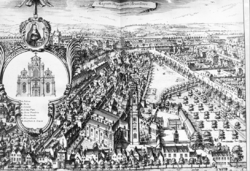Saint John the Baptist at the Béguinage
The Church of St. John the Baptist at the Béguinage (French: Église Saint-Jean-Baptiste au Béguinage, Dutch: Sint-Jan-Baptist ten Begijnhofkerk) is a Roman Catholic parish church located in Brussels, Belgium. Attributed to the Flemish architect Lucas Faydherbe, the building is a notable illustration of the Italian-influenced Flemish Baroque style of the 17th century. The church was part of the Notre-Dame de la Vigne beguinage of Brussels.
| Church of St. John the Baptist at the Béguinage Église Saint-Jean-Baptiste au Béguinage Sint-Jan-Baptist ten Begijnhofkerk | |
|---|---|
_22-09-2018_15-08-16.jpg) Facade of the church | |
| Religion | |
| Affiliation | Roman Catholic |
| Province | Archdiocese of Mechelen-Brussels |
| Ecclesiastical or organizational status | Parish |
| Year consecrated | 1676[1] |
| Location | |
| Location | City of Brussels, Brussels-Capital Region |
| Country | Belgium |
| Geographic coordinates | 50°51′9.73″N 4°21′1.68″E |
| Architecture | |
| Architect(s) | Lucas Faydherbe |
| Type | Church |
| Style | Baroque |
| Groundbreaking | 1657[1] |
| Specifications | |
| Length | 20 metres (66 ft) |
| Width | 62 metres (203 ft) |
| Width (nave) | 13 metres (43 ft) |
| Spire(s) | 1 |
History

The beguines were lay women who lived a communal life but were not bound by perpetual vows. Three court beguinages existed in Brussels but the first and largest court beguinage was the Beguinage de Notre-Dame de la Vigne which was founded before 1247 outside the city walls.[2]
Located near today's Place du Béguinage/Begijnhofplein, the community composed a miniature village of individual dwellings with a mill, laundry, and flower and vegetable garden enclosed within a wall.[3] The beguines built an infirmary and a small chapel dedicated to Our Lady of the Vineyard served as a place of worship.
Because their community had grown to 1200 beguines at the end of the 13th century, a larger Gothic church was built at the same location where the present-day building is located. The women engaged in weaving wool, and from the 16th century onward, in making lace. From the start, Rue du Béguinage/Begijnhofstraat ("Beguines Street") formed the main axis of this large triangular domain of which Rue de Laeken/Lakensestraat ("Laeken Street") formed the base. The area between Rue de Laeken and the Quai au Bois à Brûler/Brandhoutkaai was known as the Beguinage quarter during the Middle Ages.
The Beguines were dispersed in 1797 during the French regime. The grounds were parceled out gradually and streets laid out. The infirmary was renovated and transformed into the Hospice Pacheco.
In 1998, the tragic expulsion of the Nigerian asylum seeker Semira Adamu, who died after police violence, triggered the occupation of the church from October 1998 to January 1999 by political refugee candidates awaiting regularisation.[4]
Building
The previous church was a Gothic building with 3 naves and a transept that was destroyed by calvinists in 1584 during the Calvinist Republic of Brussels which lasted from 1577 to 1585.[5][6] The beguines decided to rebuild their church in Baroque style and its construction started in 1657. Attributed to the Flemish architect Lucas Faydherbe,[7] this church is a notable illustration of the Italian-influenced Flemish Baroque style of the 17th century. Its facade is considered to be one of the most beautiful in Belgium. The church was restored after it was ravaged by a fire in November 2000.[8]
In popular culture
Filmography
- The church and the surrounding streets where prominently featured in the 2018 BBC television miniseries Les Misérables.
See also
- Beguines and Beghards
- List of churches in Brussels
References
- Notes
- Patrimoine monumental de la Belgique: Bruxelles 1981, p. 165
- Patrimoine monumental de la Belgique: Bruxelles 1981, p. 104
- Simons 2003, p. 51
- "Document — Belgium: The death of Samira Adamu: Justice still awaited". Amnesty International. 2000. Retrieved 17 August 2013.
- Cook 2002, p. 34
- Cammaert 2010
- Coekelberghs & Loze 1981
- Depuydt Elbaum 2002
- Bibliography
- Cammaert, Olivier (2010). "L'iconoclasme sous la République calviniste à Bruxelles". In Weis, Monique (ed.). Des villes en révolte : les "Républiques urbaines" aux Pays-Bas et en France pendant la deuxième moitié du XVIe siècle (in French). Turnhout, Belgium: Brepols. ISBN 978-2-503-52664-5.CS1 maint: ref=harv (link)
- Coekelberghs, D.; Loze, P. (1981). L'Eglise Saint-Jean-Baptiste au Béguinage à Bruxelles et son mobilier (in French). Royal Institute for Cultural Heritage. Retrieved 17 August 2013.CS1 maint: ref=harv (link)
- Cook, Bernard A. (1 January 2002). Belgium: A History. Peter Lang. p. 34. ISBN 978-0-8204-5824-3. Retrieved 17 August 2013.CS1 maint: ref=harv (link)
- Depuydt Elbaum, Livia (2002). "L'incendie de l'église Saint Jean-Baptiste du Béguinage de Bruxelles du 25 novembre 2000 - Intervention et Bilan" (PDF) (in French). Royal Institute for Cultural Heritage. Retrieved 17 August 2013. Cite journal requires
|journal=(help)CS1 maint: ref=harv (link) - Simons, Walter (2003). Cities of ladies : Beguine communities in the medieval low countries, 1200–1565. Philadelphia: University of Pennsylvania Press. ISBN 9780812218534.CS1 maint: ref=harv (link)
- Le Patrimoine monumental de la Belgique: Bruxelles (in French). 1. Editions Mardaga. 1989. pp. 105–11. ISBN 978-2-8021-0092-8. Retrieved 17 August 2013.
External links

- Direction des Monuments et des Sites (2013). "Eglise Saint-Jean-Baptiste au Béguinage". Orgues en Région de Bruxelles-Capitale (in French). Région de Bruxelles-Capitale. Retrieved 17 August. Check date values in:
|accessdate=(help)